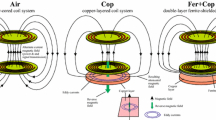Abstract
Thin metal sheets are often located in the coupling paths of magnetic coupling energy transfer (MCET) systems. Eddy currents in the metals reduce the energy transfer efficiency and can even present safety risks. This paper describes the use of etched fractal patterns in the metals to suppress the eddy currents and improve the efficiency. Simulation and experimental results show that this approach is very effective. The fractal patterns should satisfy three features, namely, breaking the metal edge, etching in the high-intensity magnetic field region, and etching through the metal in the thickness direction. Different fractal patterns lead to different results. By altering the eddy current distribution, the fractal pattern slots reduce the eddy current losses when the metals show resistance effects and suppress the induced magnetic field in the metals when the metals show inductance effects. Fractal pattern slots in multilayer high conductivity metals (e.g., Cu) reduce the induced magnetic field intensity significantly. Furthermore, transfer power, transfer efficiency, receiving efficiency, and eddy current losses all increase with the increase of the number of etched layers. These results can benefit MCET by efficient energy transfer and safe use in metal shielded equipment.
Similar content being viewed by others
References
Albesa, J., Gasulla, M., 2012. Inductive power transfer for autonomous sensors in presence of metallic structures. IEEE Int. Instrumentation and Measurement Technology Conf., p.664–669. http://dx.doi.org/10.1109/I2MTC.2012.6229658
Geselowtiz, D.B., Hoang, Q.T.N., Gaumond, R.P., 1992. The effects of metals on a transcutaneous energy transmission system. IEEE Trans. Biomed. Eng., 39(9):928–934. http://dx.doi.org/10.1109/10.256426
Ho, J.S., Yeh, A.J., Neofytou, E., et al., 2014. Wireless power transfer to deep-tissue microimplants. PNAS, 111(22):7974–7979. http://dx.doi.org/10.1073/pnas.1403002111
Kufa, M., Raida, Z., 2013. Lowpass filter with reduced fractal defected ground structure. Electron. Lett., 49(3):199–201. http://dx.doi.org/10.1049/el.2012.3473
Kurs, A., Karalis, A., Moffatt, R., et al., 2007. Wireless power transfer via strongly coupled magnetic resonances. Science, 317(5834):83–86. http://dx.doi.org/10.1126/science.1143254
Lovik, R.D., Abraham, J.P., Sparrow, E.M., 2011. Surrogate human tissue temperatures resulting from misalignment of antenna and implant during recharging of a neuromodulation device. Neuromodulation, 14(6):501–511. http://dx.doi.org/10.1111/j.1525-1403.2011.00396.x
Rani, S., Singh, A.P., 2013. Modified Koch fractal antenna with asymmetrical ground plane for multi and UWB applications. Int. J. Appl. Electrom., 42(2):259–267. http://dx.doi.org/10.3233/JAE-131662
Siakavellas, N.J., 1997. Two simple models for analytical calculation of eddy currents in thin conducting plates. IEEE Trans. Magn., 33(3):2245–2257. http://dx.doi.org/10.1109/20.573839
Ye, D.D., Yan, G.Z., Wang, K.D., et al., 2008. Development of a non-cable whole tectorial membrane micro-robot for an endoscope. J. Zhejiang Univ.-Sci. A, 9(8):1141–1149. http://dx.doi.org/10.1631/jzus.A0720074
Yu, X., Skauli, T., Skauli, B., et al., 2013. Wireless power transfer in the presence of metallic plates: experimental results. AIP Adv., 3(6):062102. http://dx.doi.org/10.1063/1.4809665
Zangl, H., Fuchs, A., Bretterklieber, T., et al., 2010. Wireless communication and power supply strategy for sensor applications within closed metal walls. IEEE Trans. Instrum. Meas., 59(6):1686–1692. http://dx.doi.org/10.1109/TIM.2009.2026602
Author information
Authors and Affiliations
Corresponding author
Additional information
Project supported by the National Natural Science Foundation of China (No. 51125028) and the National Key Technology R&D Program of China (No. 2011BAI12B07)
ORCID: Qing-feng LI, http://orcid.org/0000-0002-8827-8511
Rights and permissions
About this article
Cite this article
Li, Qf., Chen, Sb., Wang, Wm. et al. Improving the efficiency of magnetic coupling energy transfer by etching fractal patterns in the shielding metals. Frontiers Inf Technol Electronic Eng 17, 74–82 (2016). https://doi.org/10.1631/FITEE.1500114
Received:
Accepted:
Published:
Issue Date:
DOI: https://doi.org/10.1631/FITEE.1500114




